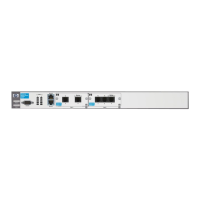12-10
Domain Name System (DNS) Services
Configuring DNS
Specifying DNS Server Addresses
No single DNS server contains the entire host table for every host on the
Internet. In order for the Internet to do its job—to allow a host in one location
to access a host in any other location—name servers must be able to query
each other about the many hosts not in their own tables.
You must specify at least one external name server for the router. This can be
a root server, or it can be a DNS server in your organization’s WAN that knows
how to reach the root server. The router will contact this server:
■ to resolve hostnames for the router (when the router is acting as a DNS
client)
■ to resolve hostnames for connected hosts (when the router is running
DNS proxy)
To configure the address for the router’s DNS server, enter:
Syntax: ip name-server <A.B.C.D> <secondary server A.B.C.D>
You may enter addresses for up to six servers (separate each with a space).
The ProCurve Secure Router will first send DNS requests to the first address
listed. For example, enter three:
ProCurve(config)# ip name-server 10.1.1.1 10.2.2.2 10.3.3.3
Use the no form of the command to remove a server from the list.
Enabling the Router to Act as a Name Server
The router will automatically act as a server for itself (for example, when you
ping a device by its hostname) as long as DNS lookup is enabled. To enable
the ProCurve Secure Router to act as a name server for connected hosts, enter:
ProCurve(config)# ip domain-proxy
When the ProCurve Secure Router receives a request from a client to translate
a hostname, it follows this process:
1. It checks its local host table for a matching entry. (See “Adding an Entry
to the Router’s Host Table” on page 12-9 to learn how to create this table.)
If it finds a match, it sends the IP address stored for the host to the client.
2. If it does not find a match, it forwards the request to an external DNS
server. (See “Specifying DNS Server Addresses” on page 12-10.) When the
router receives a reply, it forwards it to the client.
3. If the external server cannot resolve the name, the router appends the
default domain name (if configured) and resends the request.

